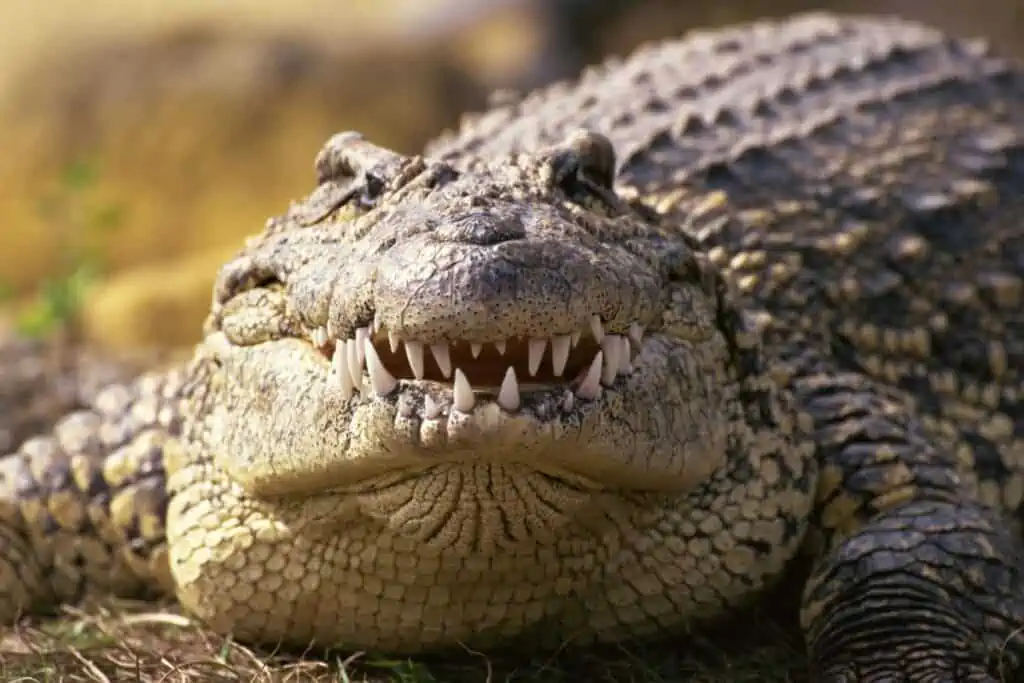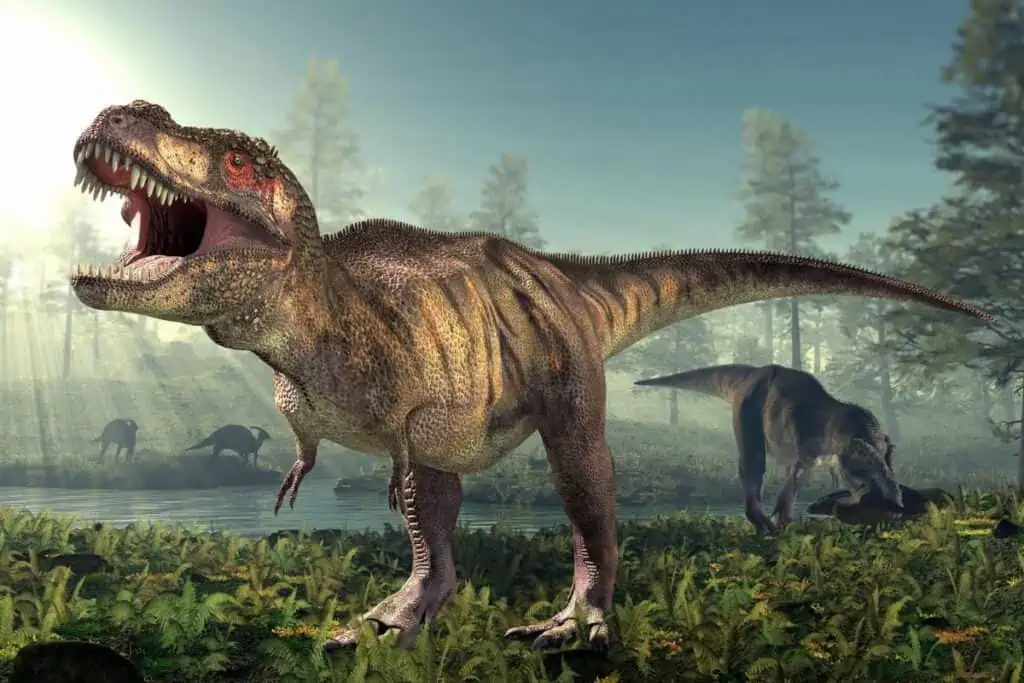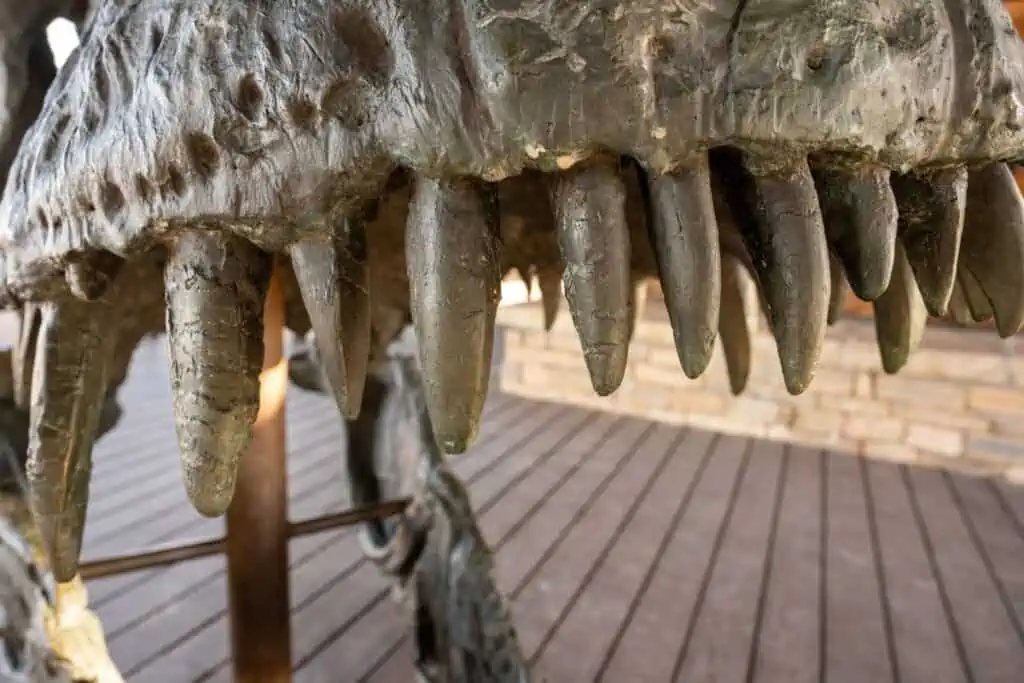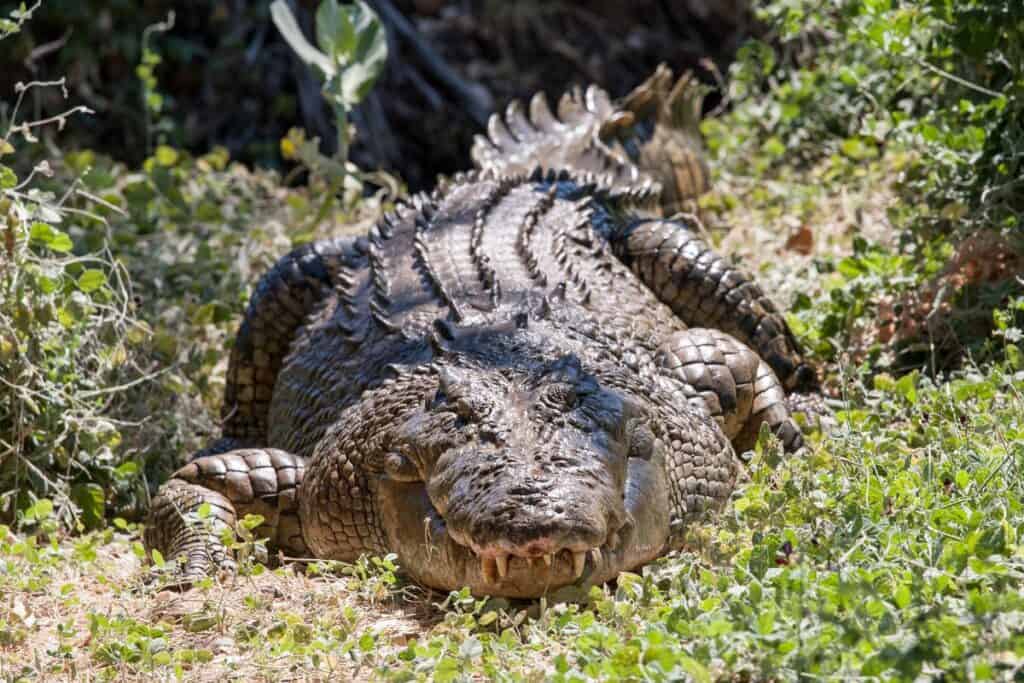Evolving millions of years ago, crocodiles are one of the oldest living animals. Crocodiles are a species of Crocodilia and are a member of the Reptilia taxonomic class.
In more than 90 countries, they can be found in freshwater streams, rivers, and marshes. Some crocodiles prefer salt water and live in brackish water near the coast. But are crocodiles dinosaurs?
Crocodiles are not dinosaurs but share a common ancestor, the Archosaurs, also known as Ruling Reptiles. Although they share this ancestry, crocodiles evolved differently from dinosaurs. Crocodiles appeared 200 million years ago, and their ancestor lived in the Triassic period with the dinosaurs.
Let’s look at the crocodile’s history and ancestral line a little further.

Why Crocodiles Are Not Dinosaurs
A crocodile is not a dinosaur, but crocodiles come from a descendant dinosaur group called Archosaurs (ruling reptiles).
These archosaurs date back to the late Triassic and early Jurassic periods (around 200 million years ago) and were reptiles like birds, crocodilians, and pterosaurs (extinct flying reptiles).
Although crocodiles and dinosaurs have a common ancestor, they evolved differently.
The Differences Between Crocodiles And Dinosaurs
Crocodiles and dinosaurs are different in the following ways:
The Descendants Of Crocodiles And Dinosaurs
Modern-day birds are descendants of feathered dinosaurs, and crocodiles evolved from reptiles that came before dinosaurs.
Modern-day crocodiles descended from prehistoric alligators like Deinosuchus.
They were low-to-the-ground predators with a long snout, a powerful tail, and lots of teeth that lived in water.
Dinosaurs were warm-blooded, while crocodiles were (and still are) cold-blooded reptiles.

The Legs Of A Crocodile Vs. A Dinosaur
Crocodiles have legs that sprawl out to the side, and their thigh bone are almost parallel to the ground. They walk and run in a side-to-side motion.
Dinosaurs stand with their legs positioned directly under their bodies.
They have a hole in their hip socket that allows them to stand upright. This posture enables dinosaurs to run faster than other reptiles of the same size.
The Jaws Of A Crocodile Vs. A Dinosaur
Crocodiles have powerful jaws with many rows of teeth. There are between 60 to 70 teeth crammed into their massive jaws.
The teeth are slightly curved and line both sides of their jaws.
A crocodile’s mouth is narrow, with the upper jaw marginally narrower than the bottom. When a crocodile closes its mouth, all its teeth are still visible. They frequently lose some of their teeth, but these grow back again.
Dinosaur bones are the only remains of these massive prehistoric creatures.
Dinosaurs are depicted as fearsome predators with extremely powerful jaws.
Carnivore dinosaurs had slender and straight jaws, whereas herbivore dinosaurs had deeper jaws with the front portion bending upward.
The deeper jaw gave the dinosaur increased jaw strength for the repetitive plant cropping when foraging for food.
Countless fossilized dinosaur teeth have been uncovered because teeth are much harder than bone. The number of teeth a dinosaur had depended on the type of dinosaur.
The long teeth with sharp edges were used for eating meat, whereas the tiny leaf-shaped teeth were used for eating plants.
The T-rex had 50 to 60 solid cone-shaped teeth, which were as big as bananas.

The Tail And Skin Of Crocodiles Vs. Dinosaurs
The crocodile’s tail is long and massive, and it propels itself through the water by whipping this powerful tail back and forth.
It’s also used as a weapon to disable its prey and knock it into the water. The crocodile’s skin is covered with scales, and they have thick, bony plates on their back.
Their hide is strong enough to protect them from a bullet and is the toughest skin in the animal kingdom.
Scientists have found that all species of dinosaurs had tails. These tails were multi-purposed and were used differently by the different species of dinosaurs.
Dinosaurs that walked with two legs needed their tails for balance. Those that walked on four legs also used their tails for balance, but some had spiked and clubbed tails for fighting and self-defense.
The fossilized skin of the dinosaur suggests that some dinosaurs had pebbly plate-like armor set into leathery skin. Others had scaly skin like that of a large lizard.
Crocodile Bite Strength Vs. Dinosaur Bite Strength
A crocodile is the largest reptile in the world and has the strongest bite force of any living animal (that we’ve been able to measure).
The Deinosuchus prehistoric dinosaur had an estimated bite force of 23,100 psi (102,750 newtons) which was greater than the bite force of the Tyrannosaurus. Rex (T. rex), which was 12,814 psi (57,000 newtons).
The crocodile’s powerful bite is due to a second jaw joint that helps enhance the force of the bite. This second joint helps distribute force and holds on to its prey.
All crocodile species have this joint, which stems from years of evolution. The primary use of their bite is for hunting and consuming prey.
Once a crocodile gets hold of its prey in their strong jaws, it is hard to get them to let go.
Are Crocodiles Older Than Dinosaurs?
Ancient crocodiles were around before or when the dinosaurs first existed.
Crocodiles are living fossils as they have been on earth for millions of years. The oldest fossil was discovered in Portugal and dates to 95 million years.
The oldest crocodilian eggs were discovered on the cliffs of western Portugal. These eggs are well preserved and were laid by the mother crocodile about 152 million years ago.
Based on the size of the largest eggs, the crocodile would have been 2 meters long. So far, this is the oldest crocodilian egg known to science.
Crocodiles are also known to live long lives, the average age being between 50 to 70 years. In captivity, crocodiles live longer than those in the wild due to there being no predators and no lack of food.
There have been recordings of saltwater crocodiles living 100 to 140 years.

Did Crocodiles Look The Same Today As 200 Million Years Ago?
Fossil remains of crocodiles from 200 million years ago look a lot like modern-day crocodiles.
Evolution seemed to have touched crocodiles the least.
Archosaur crocodiles also had stubby legs and armored scales, but their nostrils were positioned on top of the heads and not on the tips of the snout like crocodiles today.
When researching fossils of prehistoric crocodiles, scientists inspected the teeth.
They discovered that these reptiles were vegetarians instead of the modern meat-eating reptiles of today.
How Did Crocodiles Outlive The Dinosaurs?
Crocodiles survived the asteroid strike 66 million years ago that wiped out the dinosaurs.
Scientists believe the crocodile’s body shape allowed them to cope with the enormous environmental changes triggered by this significant impact.
Crocodiles have very robust bodies and immune systems that can survive significant injuries.
They can also live in total darkness, in and outside of water. They enjoy warm conditions as they cannot control their body temperatures and take warmth from the environment.
This helped them to survive the brief but drastic thermal heat released by the meteor strike. When the earth cooled down, the crocodiles survived by drawing energy from the sun.
They also did not need to eat as much as warm-blooded animals and mammals, which helped them survive.
Crocodiles lived in rivers and marshes and did not need living plants to survive.
Dead plants and animal material would have washed into the rivers from surrounding areas, and small animals would have come to eat. In turn, the crocodiles would eat these animals to survive.
The crocodiles could adapt their lifestyle to the changing environment. Crocodiles could hold their breath underwater for up to one hour.
This is due to their remarkable ability to retain oxygen. These reptiles also move around on land at high speed, making running easy in times of danger and stress. Other times they would lie around, breathing slowly and not using much energy.
Today there are only 25 species of crocodile that are still alive. Research has proved that crocodiles have a pattern of evolution triggered by a significant environmental change.
Crocodiles have also outlived two ice ages, but it may be humans who bring about their end.
Final Thoughts On Crocodiles History
Crocodiles are not dinosaurs, but they share the same ancestor. Crocodiles have lived for over 200 million years and shared the Triassic/Jurassic period with the dinosaurs.
They survived the asteroid strike 66 million years ago that wiped out the dinosaurs.
Their resilience to significant environmental change and their unique bodies allowed them to survive two ice ages.
After millions of years, 25 species of crocodile are still living today.

